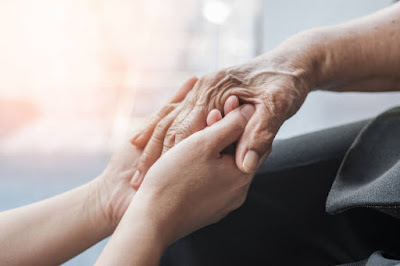Read more
The tremor can be a simple oscillating, up-and-down arm and/or leg movement, or more often it can take the form of a complex movement. It can be in the form of a slight outward rotation of the forearm, back-and-forth movements of the thumb and index fingers, and the hand counting coins or rolling a pebble between the thumb and forefinger. When the tremor occurs while standing, it resembles the act of pressing the pedal.
 |
| Can Parkinson's disease be cured? |
The
vibration, which is regular and at a certain speed, is 5 or 6 beats per second.
In Parkinson's disease, the affected hand or foot trembles at rest, unlike the
tremors seen in other diseases. The tremor disappears during sleep and when
that limb begins to move. Nervousness, walking, being under stress, or being
too busy with mental activity increase tremors. Thus, intermittent tremors may
reflect the mood of the patient. For example, a patient who does not have
tremors while reading the newspaper at home may experience tremors when a
visitor arrives. This aspect of tremor causes the patients to get into trouble
in society and many of them give up being among their friends because of this.
Patients
may even feel the subtle tremor that is invisible to the naked eye, and they
perceive it as a feeling of vibration. Abdominal tremor, which is rare, feels
like something is vibrating inside. The tremor of the diaphragm or chest
muscles feels like "palpitations" and the patient thinks that there
is a problem with the heart and applies to the relevant physician. Such tremors
can be detected on a heart electrocardiogram (ECG).
It should
be emphasized that not all people with tremors have Parkinson's. In healthy
people, temporary tremors may occur in the hands and legs in stressful
situations such as fear and excitement. Apart from this, in a benign, familial
disease called "essential tremor" that can be seen at any age,
tremors occur in the hands when the arms are extended forward. In addition to
hand tremors, tremors can also be seen, especially in the head of elderly
patients. Like many features of this disease, its treatment is different from
Parkinson's disease. Apart from this, various causes of tremor include the use
of certain drugs, overwork of the thyroid gland, or diseases of the cerebellum.
Muscle
stiffness (Rigidity)
Some
patients complain of a feeling of stiffness in their limbs. However, muscle
stiffness is often not a complaint of the patient and is recognized by the
physician's determination of the presence of resistance to passive movement on
physical examination. Instructing the patient to relax, the physician gently
stretches and bends the patient's limbs at the joints many times and looks for
resistance around the joint against this passive movement. The constant
presence of resistance to such passive movement is called "rigidity".
Normally, the muscles should be soft and loose at rest, but in the presence of
rigidity, they are seen to be constantly tense and with a certain stiffness
that can be felt by the hand, even at rest. In Parkinson's disease, rigidity is
most commonly detected in joints such as the hand, ankle, elbow, or knee.
Sometimes
muscle stiffness is felt by the physician as if there is a "gear" in
the joint. Patients may feel muscle stiffness in the form of fatigue, stinging,
pain, or cramping. Stiffness of the muscles around the spine is rare, can cause
back pain or low back pain, and is usually exacerbated by leaning forward. Calf
and foot muscle stiffness can manifest as painful cramps.
Slowing of
movements (Bradykinesia)
Slowing of
movements, namely “bradykinesia”, which is perhaps the most disabling symptom
of Parkinson's disease, develops early or late in every patient. The slowness
of movement causes all activities in daily life to be slow. The repetition of
movements at regular intervals and the range of motion of the joints decreased.
Patients experience mild difficulty in performing simple daily tasks, such as
fastening buttons, tying ties and shoes, tasks requiring delicacy, such as
writing and using cutlery, which gradually increases. Over time, difficulties
in performing most voluntary movements, such as eating and chewing, getting up
from a low seat, getting in and out of the car, and turning from side to side
in bed, can be noted. In addition to the slowing of voluntary movements
mentioned above,
No matter
how pronounced the slowness of movement is, the muscle strength of the patients
is normal. The patient's complaint in this direction is a general state of
fatigue, for example, the stiffness he feels in the limbs while walking or
brushing teeth while commanding successive movements. Such slowness in
movements can make patients dependent on others over time. A patient with
severe slowness may not have tremors or rigidity.
“Akinesia”
means inactivity and usually occurs in the advanced stages of the disease. When
Parkinson's patients with this condition are followed for a long time, it is
seen that they lose their ability to make a visible movement: blinking,
movements that create natural facial expressions (mimics), assistive movements
such as correcting sitting are not observed. Such patients simply sit still and
stare with a fixed gaze.
The Role
of Physical Education in Parkinson's Patients
Physical education movements are very important in addition to medical treatment in Parkinson's patients. It is a known fact that physically fit patients cope better with the long course of illness.
Physical education, to the extent possible, contributes to the patient's feeling better, especially due to its positive effect on muscle stiffness and slowness of movement. As it is known, unused muscles decrease in mass and shorten in length (contracture), so it is necessary to perform body movements to protect the muscle structure of the body.




0 Reviews